#dsa rpg
Explore tagged Tumblr posts
Text
I have so many images of my PnP Bard Rahjadan Zornbrecht that I painted but haven't uploaded anything featurng him since the initial character portrait and scribbles, so here's some more.

"Spätweihe Rahjadan" good future timeline, where he becomes an acolyte and later a cleric of the goddess of beauty and love (and horses and wine) there's also an evil-timeline I will probably make a post about at some point.
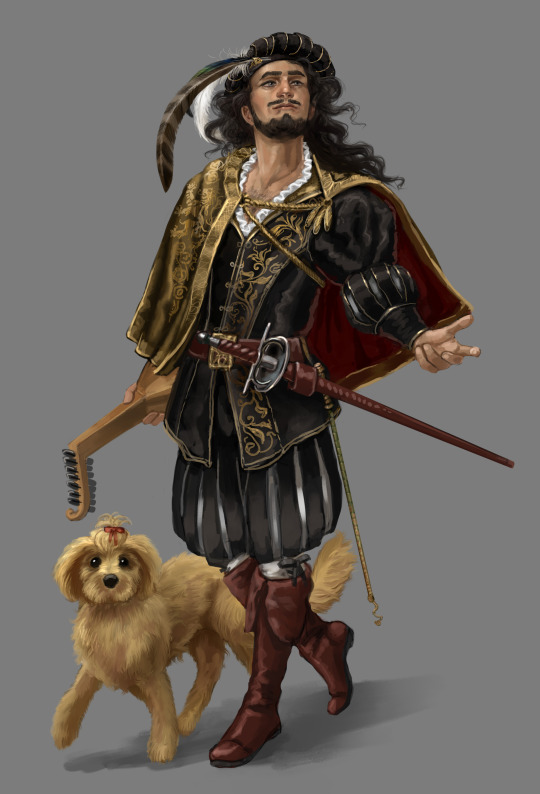
Rahjadan's current character portrait, I decided to do small updates after each session, he bought a fancy hat washed his dog, slew a harpy (big brown feather) and bought a *problematic* riding crop (actually made of Achaz (lizard people) skin, but he didn't quite understand what that meant and though it is just fancy leather)

doggo cuddle time
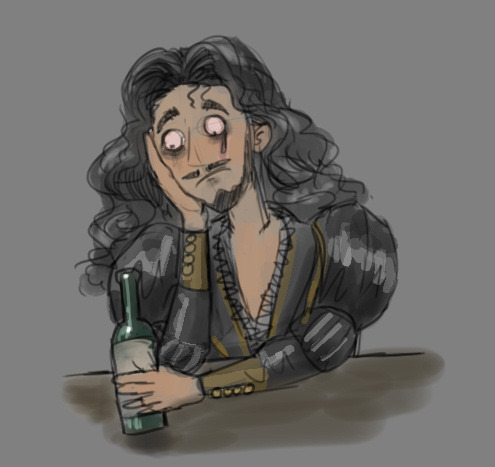

First session: Rahjadan got a letter from his pseudo-mob-boss sister he ran away from, where she threatened to kill his dog if he doesn't comply to do some research on and get in contact with the local crime gang for her. He was so distraught about the letter, that he let himself be peer pressured by his then secretly-a-master-thief-GF to break and enter into the new mansion of the (rest of the) party. ("you got debt with her, here's how you get money fast! I'm doing you a favour here, don't be such a whimp.") He proceeded to very dumb about it, got hold of a cursed artefact, got caught, and now has to do communal service (go on a pilgrimage to escort a holy animal to a monastery along with the party but not get paid for it, while he's chronically broke) and because he convinced the guards and party that he didn't mean it and will repent and its all a misunderstanding he can't really be seen asking about the local crime gang, that would look disingenuous, so now his dog is under threat to be brutalized in the future going forward, if his sister doesn't buy his low effort alibi to throw his now EX-definitely-a-master-thief-GF under the bus.

Speaking of family, that's his wannabe-mob-boss cruel older sister, Duridanya
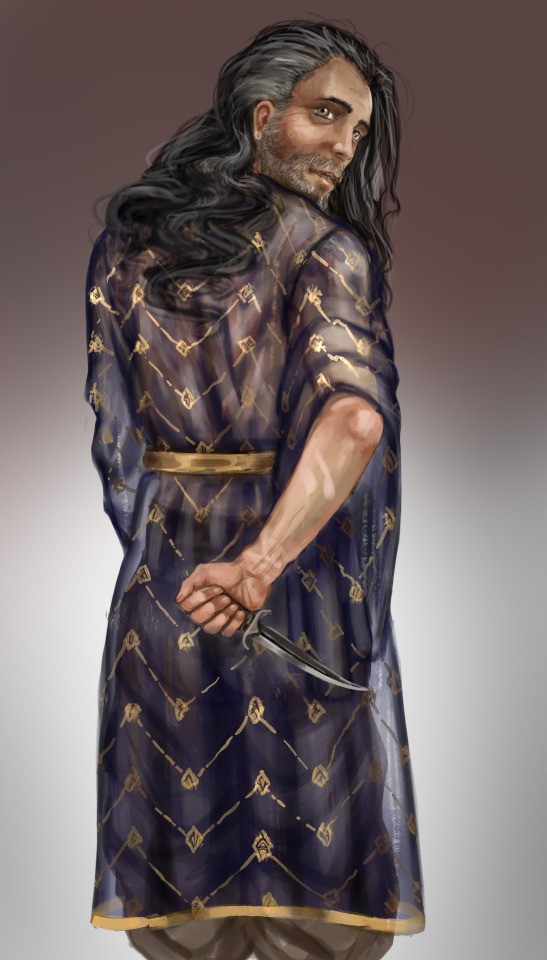
That's his paranoid, mentally messed up dad, Hesindiego.
If his sister is a wannabe-mob-boss his Mother Marchesca was the real mob-boss-terrible-person her daughter aspired to be, but can't quite reach.
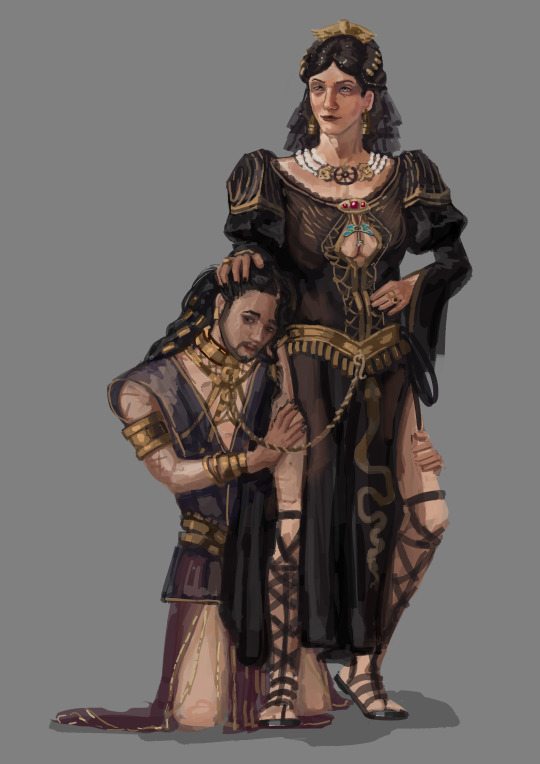
She has been dead for 10 years (poison assassination), but here's his parents before they fled the evil theocratic-slaveholder-citystate Al'Anfa, which was about half a year before Rahjadan's birth. Before that his dad was his mother's favourite domestic slave. The family dynamic is complicated to say the least.
While being raised by both parents, Rahjadan got some very conflicting information regarding morality in general and their grand house (one of the richest in Al'Anfa, and the one with the highest reputation for cruelty).
While his Narcissistic Mother would always tell agrandizing stories about the family, their ancestors and heroc (read horrible) deeds that disowned her and has probably multiple times attempted to assassinate her since she fled north to the city of Lowangen,as if she would come back south gloriously conquering one day. His dad on the other hand told him about the horrors and hypocrisy of Al'Anfa he witnessed first hand. His sister always despised him, and wa shis greatest bully for his entire life, once teh parents got wind of her physically abusing Rahjadan as a kid (10 years age gap) , she switched to emotional blackmail and, after the death of their mother and once this was not working anymore she wsitched to financial blackmail.
His dad completely dropped the mask of pretense and "being a good husband" and that they are "a normal family" after Marchesca's death, and became increasingly estranged from his kids, due to untreated trauma/mental struggles. Although Rahajdan and him are still very much on speaking terms, Rahjadan kinda wished he had his "real dad" back and he feels terrible about it, knowing that it was all an act his dad put on for his controlling wife and his kids, and he never really knew his dad for who he was.
Meanwhile his Sister pressures him with crusing dept he got into to sustain his lavish lifestyle (and the fact he can't say no to buying beautiful and shiny things), to do all sorts of shitty and possibly illegal things for her. She began inserting herself into his private and love life until it reached a breaking point and Rahjadan just decided to screw it all, he's gonna leave the city tonight, and be a wandering bard, at least he'll not starve that way and usually have a warm bed somewhere, and is free to do whatever he pleases (he thinks, he's kind dumb actually, intelligence 9 when the lowest possible value is 8 in the TDE PnP system). And thats the state he was in when he met the Plot (TM).
#rahjadan#feivelynart#feivelyn#das schwarze auge#dsa rpg#rpg bard#art#the dark eye#al'anfa#Zornbrecht
10 notes
·
View notes
Text
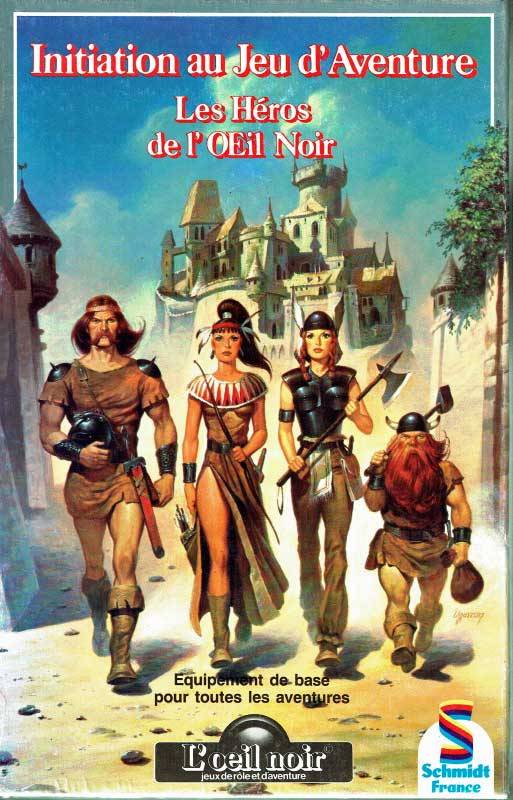
The party sets out for adventure -- Ugurcan Yüce cover for The Dark Eye introductory box set, Schmidt Spiele -- Schmidt France version "L'Œil noir;" originally released in German as "Das Schwarze Auge" (DSA). This art has been attributed to a second alternative version of the 1984 1st edition, and to the 1988 2nd edition.
#The Dark Eye#Ugurcan Yuce#Ugurcan Yüce#Das Schwarze Auge#l'oeil noir#JDR#jeu de role#jeu de rôle#L'Œil noir#DSA#Initiation au Jeu d'Aventure#fantasy RPG#adventuring party#castle#fantasy castle#1980s
176 notes
·
View notes
Note
When i was younger here in Germany most ttrpg players i know played a system called "Das Schwarze Auge" (DSA), which has a fantasy setting comparable to D&D. (and honestly the rules are rather complicated in places, too) But over the last couple of years i kinda saw this game fade into background. Because of the dominance of US-American popculture D&D overtook the market. And while i generally enjoy D&D, it kinda worries me how much the system just pushes other systems out of the picture.
I mean, DSA sucks too (at least the version I played. Unnecessarily complicated resolution mechanic plus I really don't care about medieval fantasy at all...)
Like, I get what you mean, but let's be real, DSA was the D&D of Germany. It had generally the same role in the German TTRPG space, and I personally don't think one cultural monopoly is inherently better than another?
#dsa#das schwarze auge#the dark eye#dnd#dungeons & dragons#dungeons and dragons#d&d#ttrpg#tabletop rpg
13 notes
·
View notes
Text
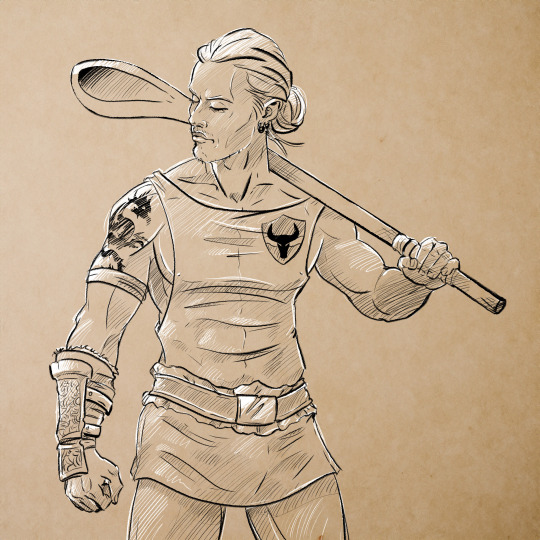
Something not Warhammer-related: Revro, the professional Imman-player.
In Germany, the role-playing game system DSA ("Das Schwarze Auge" - "The Black Eye"), now also forty years old, is more popular than D&D. It has much more complex rules (both blessing and curse) and is more geared towards building a character that fits into the incredibly detailed world and interacting with the creatures and circumstances there. The power level is lower and the characters rarely become overpowered heroes. On the other hand, there is the opportunity to explore all kinds of well-developed areas, cities and political contexts and you can easily be a travelling blacksmith, a cartographer or a wonderfully useless, incredibly nerdy mage. Or a trader, a mercenary who is actually a cook (or vice versa) or a tattoo-artist.
Of course, this also means that an average DSA adventure is not a dungeon crawl.
Which led to our game master "gifting" us an NPC who is a celebrated Imman player in Havena the not very mage-friendly town we are currently involuntarily staying in. Imman is a very popular team sport, distantly related to hurling. Revro, that's his name, plays for the Havena Bulls and has developed a crush on my clueless mage. Much to the continued amusement of the rest of our group.
Doesn't matter - my mage is happy. Finally, someone who is willing to listen to his elaborate explanations of old-puninian number magic!
And because I had so much fun with Revro, I sketched him and hope we can keep him.
22 notes
·
View notes
Text

I drew our group in DSA
Everyone has the trait "good looking" except one guy. It happened by chance too. We all wanted some hot characters I guess XD
This one is mine

Valerio Loriano! Bard and Swords man!
3 notes
·
View notes
Text
The Oldest TTRPG Forum on the Net
Did you know there is an online forum for tabletop role-playing games that has been around since the late 70s, and which still is active and operating? Admittedly in a much diminished state than at it’s heyday. I don’t know if you ever heard the term Usenet before, and even if you did, if you don’t just connect it with data piracy. Because that’s what it is mostly used for nowadays. What it…

View On WordPress
3 notes
·
View notes
Text

A DSA module I gave to my friend for birthday last week.
0 notes
Text
I was once again allowed to paint a map illustration for "Das schwarze Auge" and Ulisses Games: "The Andergast Borderland" for "The Seed of the Black Oak". It was a pleasure again!😊
AD: Steffen Brand

#dsa#thedarkeye#ulisses#dasschwarzeauge#tabletopgames#ttrpg#rpg#map#illustration#fantasyart#gameart#annajägerhauer#annajaegerhauer#linestyleartwork#fantasy#penandpaper#karten#abenteuer#artistslife#fantasyartist#commission#noai#games#rollenspielen#fantasymap#digitalart#art#wacom#photoshop#artistsontumblr
1 note
·
View note
Text
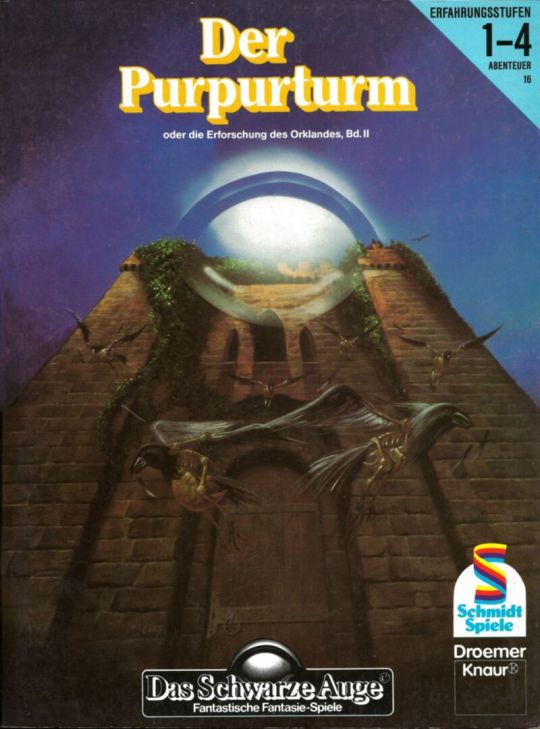
The Purple Tower – Der Purpurturm, The Exploration of Orclands, Volume I, Adventure 16 for Das Schwarze Auge, Schmidt Spiele, 1987 (Claus D Biswanger cover art, Ulrich Kiesow author)
1 note
·
View note
Note
Have you ever had any experiences with DSA? Das Schwarze Auge *is* a German game ,but I'm wondering if it's ever breaking containment nowadays
I know of it! The English translation of it has been featured in a number of Bundles of Holding so I wouldn't be surprised if it showed up there again, and as far as I know it's actually been used as the basis for a number of CRPGs, including the Blackguards series and the Realms of Arkania series (which was incidentally my first encounter with the series)!
It is relatively obscure outside of Germany but has still sort of broken containment enough to warrant multiple translations, so it clearly has an international audience! Which I think is great: just like it's cool that Dragonbane, formerly Drakar och Demoner, Sweden's premier fantasy RPG has gotten an English translation, I think it's extremely cool when originally non-English language RPGs get to reach a wider audience.
Speaking my personal encounter with the series, Realms of Arkania: Shadows over Riva was weirdly enough translated into Finnish in the nineties. It owns.
youtube
30 notes
·
View notes
Text






Das Schwarze Auge/The Dark Eye PCs in the style of Darkest Dungeon
20 notes
·
View notes
Text
So, sitting on a train, there are like, 3 other people next to you, yea?
What are the odds that one of them notices me staring at her, I tell her I’m trying to read the writing on that sticker on her headphones: she tells me it’s a sticker from the indie music festival she runs. Which she tells me is in a castle ruin. I tell her that I too hang out in castle ruins a lot, and if they get any larper.
They do, Witcher larp specifically. Person 3/4 joins in to talk about the Witcher, asks what other kinds of larp there are. I mention DSA. He has spent his entire childhood getting absorbed into that world but was afraid to talk to anyone about that stuff as an adult.
Person 4 hears we are talking about pen and paper rpgs and joins in with some Star Wars edge of the empire anecdotes.
Sadly had only four or five stops with these amazing people, but it’s still great to just find others out in the wild
3 notes
·
View notes
Text
Aventuria: Entdecke eine andere Welt
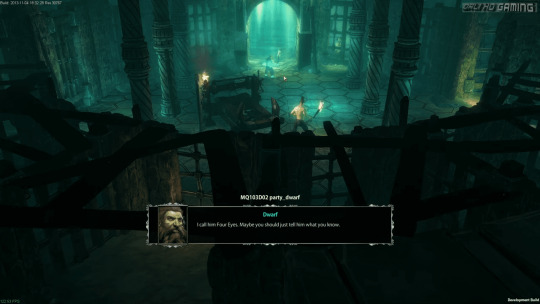
Tauche ein in eine Welt, in der jede Ecke von alten Mythen umflüstert und von legendären Helden durchstreift wird. Aventuria wartet darauf, dass mutige Abenteurer seine Geheimnisse enthüllen und seine Schätze heben. Von den eisigen Klippen des Hohen Nordens über die dunklen, gefährlichen Wälder des Mittelreiches bis hin zu den schimmernden Sanden der Khôm-Wüste – in Aventuria vereinen sich zahllose Geschichten zu einem epischen Panorama. In Aventuria, dem Herzen des "Das Schwarze Auge" Universums, wird jede Entscheidung zu einem Teil der Legende. Erschaffe deinen eigenen Weg durch tückische Königreiche, verhandle mit listigen Feen und stelle dich den dunklen Kreaturen, die im Schatten lauern. Spiele im Universum von Aventuria Aventuria ist das fiktive Kontinent-Setting für "Das Schwarze Auge" (DSA), eines der populärsten Rollenspielsysteme im deutschsprachigen Raum. Verschiedene Spiele, sowohl analog als auch digital, nutzen dieses reiche und detaillierte Fantasy-Universum für ihre Hintergrundgeschichte und Weltgestaltung. Das Schwarze Auge: Drakensang "Drakensang" ist wohl eines der bekanntesten PC-Rollenspiele, das in Aventuria angesiedelt ist. Es ist ein klassisches RPG, das dich mit einer tiefgehenden Geschichte und einem komplexen Regelwerk begrüßt, welche beide auf dem DSA-Lizenz basieren. Das Schwarze Auge: Blackguards-Serie Die "Blackguards"-Serie, die aus "Blackguards" und "Blackguards 2" besteht, bietet eine dunklere und taktischere Annäherung an das Universum. Diese Spiele sind für ihr herausforderndes rundenbasiertes Kampfsystem bekannt und stellen eine Abkehr von den typischen Heldenpfaden dar. Das Schwarze Auge: Satinavs Ketten & Memoria Diese beiden Spiele sind Point-and-Click-Adventure, die eine tiefere Erzählweise mit Rätseln und Charakterentwicklung verbinden. "Das Schwarze Auge: Satinavs Ketten" und seine Fortsetzung "Memoria" entführen den Spieler in eine Welt voller Legenden und Mythen. Das Schwarze Auge: Herokon Online "Herokon Online" war ein MMORPG, das den Spielern die Möglichkeit gab, ihre eigene Geschichte in der Welt von Aventuria zu schreiben. Obwohl es nicht mehr aktiv ist, bot es eine umfangreiche Online-Erfahrung im DSA-Universum. Das Schwarze Auge: Demonicon "Demonicon" ist ein Action-Rollenspiel, das eine düstere Geschichte innerhalb Aventurias erzählt. Es legt den Fokus auf Kampf und Charakterentwicklung und bietet eine weitere Perspektive auf die vielschichtige Welt von DSA. Brettspiele und Kartenspiele Neben digitalen Spielen gibt es auch eine Vielzahl von Brett- und Kartenspielen, die in der Welt von Aventuria angesiedelt sind. "Das Schwarze Auge: Aventuria - Abenteuerkartenspiel" ist ein beliebtes Beispiel, das die Spieler in Form eines Kartenspiels auf Abenteuer in dieser Welt mitnimmt. Die Welt verschiedener Games Die Welt von Aventuria dient als ein reichhaltiger Nährboden für unterschiedliche Spieltypen und Genres. Von klassischen Rollenspielen bis hin zu taktischen Kampfspielen und interaktiven Adventures, das Universum von "Das Schwarze Auge" bietet eine Vielzahl an Erlebnissen für verschiedene Spielertypen und ist ein zentraler Bestandteil der deutschsprachigen Spielekultur. ©Daedalic Entertainment. Die Vielfalt der Aventurischen Landschaft Aventuria, die Welt von "Das Schwarze Auge", ist bekannt für ihre reiche und vielfältige Landschaft, die von eisigen Nordlanden bis zu heißen Wüsten im Süden reicht. Hier eine kurze Reise durch die verschiedenen Regionen Aventurias und ihre charakteristischen Landschaftsmerkmale: Der Hohe Norden Im hohen Norden finden sich die eisbedeckten Gebiete Aventuriens, wie das Gletscherreich Glorania, ein unwirtliches und raues Land, das von Frostriesen und Nordmenschen bewohnt wird. Der Thorwaler Küstenstrich, bekannt durch seine seefahrenden Wikinger-ähnlichen Bewohner, bietet felsige Küsten und stürmische Meere. Die Mittelreiche Das Herzland Aventuriens bildet eine gemäßigte Zone mit weiten Wäldern, fruchtbaren Ebenen und dem Flusslauf der großen Ströme, wie dem mächtigen Bosparan. Das Mittelland ist kulturell und politisch das Zentrum von Aventuria, Heimat von Städten wie Gareth und Havena. Das Bornland und die Nordmarken Im Nordosten liegen das Bornland und die Nordmarken. Das Bornland zeichnet sich durch weite, dünn besiedelte Wälder und Moore aus, während die Nordmarken als rau und hügelig gelten, mit zahlreichen Burgen und Festungen. Die Waldinseln Die Waldinseln bestehen aus großflächigen, unberührten Waldgebieten, die von Elfen bewohnt werden. Sie sind geheimnisvoll und schwer zu durchqueren, voller alter Magie und mythischer Kreaturen. Der Schwarze Wald Der Schwarze Wald im Südwesten ist ein dichter, dunkler Wald, der bei Reisenden oft Furcht auslöst, da er Heimat von Räubern und gefährlichen Bestien ist. Aranien und das Mhanadistan Im Süden, grenzend an die Tulamidenlande, finden sich Aranien und das Mhanadistan. Diese Gebiete sind geprägt von weiten Steppen und der khôm-Wüste, die das Land mit ihrer trockenen Hitze dominiert. Das Meer der Sieben Winde Das Meer der Sieben Winde ist das große Gewässer, das viele Küsten Aventuriens berührt und Handel sowie Seefahrt ermöglicht. Es ist lebenswichtig für die verschiedenen Küstenstädte und -kulturen. Die Landschaften Aventuriens Die Landschaften Aventuriens sind in "Das Schwarze Auge" nicht nur Hintergrundkulisse, sondern spielen eine wichtige Rolle in der Spielmechanik und der Atmosphäre der Abenteuer. Sie sind so gestaltet, dass sie zu den kulturellen Eigenheiten der Bewohner passen und die Vielfalt von Flora und Fauna reflektieren. Jede Region bringt eigene Herausforderungen und Geschichten mit sich, die die Spieler in den Bann ziehen und für ein abwechslungsreiches Spiel sorgen. Glorania: Das Ewige Eis Aventuriens Glorania, auch bekannt als das Gletscherreich, ist eine Region in Aventurien, die sich durch ihre unwirtliche und erbarmungslose Umgebung auszeichnet. Es ist ein Land, in dem das Eis nicht nur die Landschaft, sondern auch das Leben und die Kultur seiner Bewohner geformt hat. Die Unbarmherzige Natur Das Klima in Glorania ist rau und unerbittlich, mit langen, dunklen Wintern und kurzen Sommern, in denen das Eis nur teilweise schmilzt. Die Landschaft wird von mächtigen Gletschern, zugefrorenen Flüssen und schroffen Bergspitzen dominiert. Reisende und Abenteurer, die sich in diese Region wagen, müssen sich gegen die extreme Kälte und plötzliche Schneestürme wappnen. Bewohner des Eises Das Gletscherreich ist Heimat für verschiedene Völker und Kreaturen, die sich an das Leben in der Kälte angepasst haben. Frostriesen und eisige Elementarwesen durchstreifen die Gletscher, während die wenigen menschlichen Siedler sich in festen, isolierten Gemeinschaften organisieren. Ihre Kultur ist geprägt von starken Traditionen und einem engen Zusammenhalt, der zum Überleben in dieser unwirtlichen Umgebung nötig ist. Mythen und Legenden Glorania ist eingehüllt in Mythen. Geschichten von versunkenen Städten unter dem Eis und von Geistern, die in den Schneestürmen umherirren, sind in den lokalen Sagen allgegenwärtig. Mutige Helden, die sich den Geheimnissen Glorianas stellen, können nicht nur physische Reichtümer entdecken, sondern auch längst vergessenes Wissen der alten Zeiten. Herausforderungen für Abenteurer Für diejenigen, die den Nervenkitzel suchen, bietet Glorania unzählige Herausforderungen. Von der Jagd nach einem sagenumwobenen Artefakt, das in einem ewigen Eisblock eingefroren ist, über das Überleben in einer der härtesten Umgebungen Aventuriens bis hin zum Kampf gegen die Kreaturen des Frostes – Glorania ist der ultimative Test für Ausdauer und Mut. Der Thorwaler Küstenstrich: Zwischen Meer und Mythos Der Thorwaler Küstenstrich in Aventurien ist eine Region, die durch ihre rauen Küsten, die tosende See und ihre ebenso robusten wie seefahrenden Bewohner bekannt ist. Es ist ein Land, in dem das Meer das Leben bestimmt und alte Traditionen tief in der Gesellschaft verwurzelt sind. Leben am und mit dem Meer Das Leben in Thorwal ist untrennbar mit dem Meer verbunden. Die Menschen hier sind als hervorragende Schiffsbauer und mutige Seefahrer bekannt. Sie ernähren sich hauptsächlich von dem, was das Meer ihnen bietet, sei es durch Fischfang oder die Jagd auf Meeresungeheuer. Die Küste selbst ist wild und ungezähmt, mit steilen Klippen und ausgedehnten Stränden, die von den Wellen des rauen Meer der Sieben Winde umspült werden. Kultur der Thorwaler Thorwaler sind bekannt für ihre Unabhängigkeit und ihren Kampfgeist. Die sozialen Strukturen sind häufig an alte Clanbindungen und Ehrenkodizes geknüpft. Ihre Geschichten und Lieder, voll von Heldentaten und den Launen der Götter, werden in langen Winternächten von Generation zu Generation weitergegeben. Thorwal ist auch die Heimat der legendären Hetfrauen, weibliche Anführerinnen, die in politischen und militärischen Belangen ebenso einflussreich sind wie ihre männlichen Gegenstücke. Göttlicher Glaube und Aberglaube Der Glaube spielt eine zentrale Rolle in Thorwal. Besonders Swafnir, der Gott der Meere und Wale, ist in der Region verehrt. Die Thorwaler glauben, dass ihre Schicksale vom Willen der Götter abhängen, und opfern einen Teil ihrer Ernte und ihres Fangs, um die Götter gnädig zu stimmen. Aberglaube und Rituale sind fester Bestandteil des Alltags, und Orakel werden oft konsultiert, bevor wichtige Entscheidungen getroffen werden. Herausforderungen für Abenteurer Für Abenteurer bietet der Thorwaler Küstenstrich eine Fülle an Möglichkeiten: vom Beitritt zu einer der legendären Drachenboot-Mannschaften über die Erforschung alter, verfluchter Ruinen bis hin zum Kampf gegen die wilden Kreaturen des Meeres. Die Thorwaler selbst schätzen Tapferkeit und Taten, die in Liedern besungen werden können – wer sich hier einen Namen macht, wird Teil der unendlichen Sagen Thorwals. Ein kontrastreiches Land Der Thorwaler Küstenstrich ist ein Landstrich voller Kontraste – zwischen der Gewalt des Meeres und der Wärme der Gemeinschaft, zwischen uralter Tradition und dem rauen Alltag. Es ist ein Ort, der Charaktere formt und Geschichten schreibt, die so tief und unergründlich sind wie das Meer selbst. Wer Aventurien in seiner ganzen Bandbreite erleben möchte, kommt an den sagenumwobenen Küsten Thorwals nicht vorbei. Weiter geht es zu einem Artikel über Aventuria Lesen Sie den ganzen Artikel
2 notes
·
View notes
Text
Just to clarify, the store is about equally focused on board games and miniature games with tcgs and rpgs being more of a secondary thing, I think the only ttrpgs they sell are CoC, Shadowrun, DSA and a bit of DnD so the owner isn't too much of a ttrpg expert
Went to my LGS to preorder the LANCER physical book coming out next year and the owner didn't know what LANCER was, I felt like this

2K notes
·
View notes
Photo

Hell yeah I’m an artist
#art#digital art#digital painting#scenery#illustration.#dsa#dsa rpg#das schwarze auge#dnd#zorgan#dsa zorgan#schleiertanz#ezra saba faruk sala atherion#rondril feenwardt von weißenstein#mages#guild mages#mine#made in photoshop#photoshop#photoshop illustration#illu
7 notes
·
View notes
Text
[Das Schwarze Auge] Some interesting social skills
Dancing girls at Cairo illustration by David Roberts (1796-1864). I was reminiscenced about skills in Das Schwarze Auge again the last few days, mostly while trying to think about ways of including the parts I really liked into my own DnDish houserule-monster of a ruleset. Skills haven’t been part of DSA from the beginning. The original boxed set did not come with a proper skill system. Like…

View On WordPress
0 notes